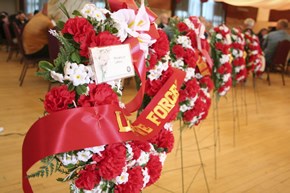Safety in mines has improved dramatically since the 1980s, when up to 20 miners died on the job every year, but there's still a lot of work to be done, according to an Ontario Ministry of Labour official.
"From 2004 up until December of 2005, we went 18 months without
a fatality, and then in a manner of seven months, we had four
fatalities related to the mining industry. We have a long way
to go yet," says Bernie Deck.
He made the comments to about 200 people who had gathered
at the Caruso Club Tuesday for a Workers' Memorial Day
ceremony.
The event is put on by the Sudbury Mine, Mill & Smelter Workers' Union Local 598/CAW every year on June 20 in honour of four miners who lost their lives at Falconbridge Mine on that day in 1984.
A rockburst killed Sulo Korpela, Richard Chenier and Daniel
Lavallee instantly. Wayne St. Michel, 22, lived for 27 hours
buried in rock debris, but died before a mine rescue crew could
reach him.
Deck has vivid memories of the disaster. He heard about the
workers' fate while driving home from Wawa, where he had
testified at the inquest into the death of another young
miner.
"I was devastated because I had just come from an inquest. I
was devastated for the four workers who had lost their lives. I
was devastated for their family and friends."
Local 598/CAW president Rick Grylls echoed Deck's comments. He
pointed out that while less miners are dying in accidents, more
are getting sick from industrial diseases like diesel emphysema
and silicosis.
"In the 30 years I've been involved in the health and safety
committees in our workplace, the constant resistance we face is
the dollars it will cost to improve the dust control, smelter
and engine emissions," says Grylls.
"I believe we have made progress in our workplaces, and we have
learned from our workplace health and safety committees. Is the
system perfect? No. Does it have room to improve? Yes."
Gary Hrytsak, who led the memorial day ceremony, will never
forget the 1984 rockburst disaster. He was eating his lunch at
a smelter near the mine when the incident occurred.
"The hit was hard enough that you actually got jostled off your
bench that distance away. None of us knew what was happening.
The dust in the smelter was just horrible because it shook the
dust off the beams," says Hrytsak, a retired miner and union
member.
"We looked toward Number Five shaft, and there was a tremendous
plume coming off of it, and we knew something was wrong. We
didn't know the extent of it."
There was jubilation mixed with sadness for the dead workers
when people found out St. Michel was still alive, says
Hrytsak.
"He was almost rescued. It was a drama gone wild. They were
talking to him and he was thirsty. The next word is he didn't
survive it. His injuries were such that upon the release from
the tomb he was in, he died a very few minutes after that."
"Unfortunately, in the last year, we've lost miners in our
industry here in Northern Ontario. We've lost miners
internationally in coal mines. We've had some miracles of
survival of miners trapped for days in that darkness. These are
the things that we don't want to have happen again, he
said.
